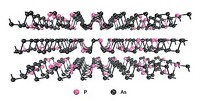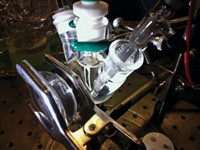Advertisement
Grab your lab coat. Let's get started
Welcome!
Welcome!
Create an account below to get 6 C&EN articles per month, receive newsletters and more - all free.
It seems this is your first time logging in online. Please enter the following information to continue.
As an ACS member you automatically get access to this site. All we need is few more details to create your reading experience.
Not you? Sign in with a different account.
Not you? Sign in with a different account.
ERROR 1
ERROR 1
ERROR 2
ERROR 2
ERROR 2
ERROR 2
ERROR 2
Password and Confirm password must match.
If you have an ACS member number, please enter it here so we can link this account to your membership. (optional)
ERROR 2
ACS values your privacy. By submitting your information, you are gaining access to C&EN and subscribing to our weekly newsletter. We use the information you provide to make your reading experience better, and we will never sell your data to third party members.
Materials
Engineering Titanium Dioxide To Respond To Visible Light
Photocatalysis: Gently depositing nitrogen atoms on the surface of TiO2 makes the material active across a broader range of wavelengths of light
by Alexander Hellemans
January 8, 2014
Many scientists view titanium dioxide as an attractive, low-cost photocatalyst for a variety of applications, including water purification, water splitting, and solar power. But there is one snag: The material catalyzes reactions only in response to ultraviolet light. Now, researchers in Singapore have found a way to dope TiO2 with nitrogen so that it responds to visible light, drastically increasing its activity in sunlight (J. Phys. Chem. C 2013, DOI: 10.1021/jp408798f).
A material’s photoactivity depends in part on its band gap, the energy needed to kick electrons from a nonconductive state to a conductive one. TiO2 has a band gap of 3 eV, which corresponds to energies of photons in the UV range. Doping TiO2 with nitrogen lowers the band gap below 2 eV, making the material photoactive with visible light. However, up to now, the doping methods used, such as magnetron sputtering and high-energy ion bombardment, have created defects in the bulk TiO2, which reduced the photocatalytic efficiency of the material.
A team of researchers from the Institute of Materials Research & Engineering (IMRE) and the National University of Singapore used a different source of nitrogen atoms that sent low-speed beams of atoms at the TiO2. Because these nitrogen atoms did not penetrate beyond the TiO2 surface, the researchers could replace the top layer of the material with nitrogen and create a defect-free surface, says Junguang Tao, a physicist at IMRE.
The team measured the photocatalytic activity of TiO2 samples with and without a nitrogen-doped surface. The doped TiO2 showed photoactivity when illuminated with visible light, unlike the undoped TiO2. What’s more, the surface-doped TiO2 showed greatly enhanced photoactivity under UV illumination, unlike TiO2 doped using previous methods.





Join the conversation
Contact the reporter
Submit a Letter to the Editor for publication
Engage with us on Twitter